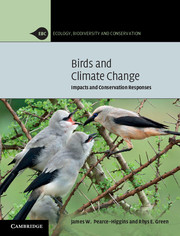Foreword
Published online by Cambridge University Press: 05 June 2014
Summary
If you ask anyone what he or she considers to be the greatest environmental problem of our times, it is likely that Climate Change, or something similar to this, will be the reply. The unusual weather patterns – droughts in some parts of the planet, floods in other parts, temperature records (both maxima and minima) being broken, the frequency of cyclones and gales – are associated phenomena. A couple of decades ago, as well as predictions of rising average temperature, another prediction was that there would be more frequent extreme events. So it is not just the trends in warmth or rainfall, or those of the melting of Arctic sea ice or of glaciers, that affect birds, but also the extremes of all aspects of our climate.
Try asking people about their favourite wildlife and almost certainly Birds will feature strongly in the replies. Birds have a charisma which appeals to so many people. Small birds inhabit our gardens and parks, larger birds are a feature of our coasts, estuaries and seas, and the raptors – owls, hawks and eagles – have a particular appeal. Although there are other charismatic and iconic species of wildlife, birds have a particular appeal because they fly by day, occur everywhere and often interact with people because of their endearing habits.
- Type
- Chapter
- Information
- Birds and Climate ChangeImpacts and Conservation Responses, pp. x - xiPublisher: Cambridge University PressPrint publication year: 2014



